Hexagon
| Regular hexagon | |
|---|---|
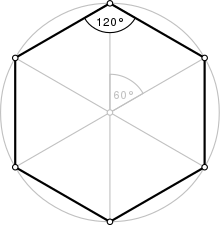 A regular hexagon | |
| Type | Regular polygon |
Edges and vertices | 6 |
| Schläfli symbol | 6, t3 |
| Coxeter diagram | |
| Symmetry group | Dihedral (D6), order 2×6 |
Internal angle (degrees) | 120° |
| Dual polygon | Self |
| Properties | Convex, cyclic, equilateral, isogonal, isotoxal |
In geometry, a hexagon (from Greek ἕξ hex, "six" and γωνία, gonía, "corner, angle") is a six-sided polygon or 6-gon. The total of the internal angles of any simple (non-self-intersecting) hexagon is 720°.
Contents
1 Regular hexagon
1.1 Parameters
2 Symmetry
2.1 A2 and G2 groups
3 Dissection
4 Related polygons and tilings
5 Hexagonal structures
6 Tesselations by hexagons
7 Hexagon inscribed in a conic section
7.1 Cyclic hexagon
8 Hexagon tangential to a conic section
9 Equilateral triangles on the sides of an arbitrary hexagon
10 Skew hexagon
10.1 Petrie polygons
11 Convex equilateral hexagon
11.1 Polyhedra with hexagons
12 Hexagons: natural and human-made
13 See also
14 References
15 External links
Regular hexagon
A regular hexagon has Schläfli symbol 6[1] and can also be constructed as a truncated equilateral triangle, t3, which alternates two types of edges.
@media all and (max-width:720px).mw-parser-output .tmulti>.thumbinnerwidth:100%!important;max-width:none!important.mw-parser-output .tmulti .tsinglefloat:none!important;max-width:none!important;width:100%!important;text-align:center

 2 × 3, a product of a power of two and distinct Fermat primes.
2 × 3, a product of a power of two and distinct Fermat primes.
A regular hexagon is defined as a hexagon that is both equilateral and equiangular. It is bicentric, meaning that it is both cyclic (has a circumscribed circle) and tangential (has an inscribed circle).
The common length of the sides equals the radius of the circumscribed circle, which equals 23displaystyle tfrac 2sqrt 3
Like squares and equilateral triangles, regular hexagons fit together without any gaps to tile the plane (three hexagons meeting at every vertex), and so are useful for constructing tessellations. The cells of a beehive honeycomb are hexagonal for this reason and because the shape makes efficient use of space and building materials. The Voronoi diagram of a regular triangular lattice is the honeycomb tessellation of hexagons. It is not usually considered a triambus, although it is equilateral.
Parameters
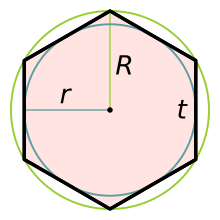
The maximal diameter (which corresponds to the long diagonal of the hexagon), D, is twice the maximal radius or circumradius, R, which equals the side length, t. The minimal diameter or the diameter of the inscribed circle (separation of parallel sides, flat-to-flat distance, short diagonal or height when resting on a flat base), d, is twice the minimal radius or inradius, r. The maxima and minima are related by the same factor:
12d=r=cos(30∘)R=32R=32tdisplaystyle frac 12d=r=cos(30^circ )R=frac sqrt 32R=frac sqrt 32tand, similarly, d=32D.displaystyle d=frac sqrt 32D.
The area of a regular hexagon
- A=332R2=3Rr=23r2=338D2=34Dd=32d2≈2.598R2≈3.464r2≈0.6495D2≈0.866d2.displaystyle beginalignedA&=frac 3sqrt 32R^2=3Rr=2sqrt 3r^2\&=frac 3sqrt 38D^2=frac 34Dd=frac sqrt 32d^2\&approx 2.598R^2approx 3.464r^2\&approx 0.6495D^2approx 0.866d^2.endaligned
For any regular polygon, the area can also be expressed in terms of the apothem a and the perimeter p. For the regular hexagon these are given by a = r, and p=6R=4r3displaystyle =6R=4rsqrt 3
- A=ap2=r⋅4r32=2r23≈3.464r2.displaystyle beginalignedA&=frac ap2\&=frac rcdot 4rsqrt 32=2r^2sqrt 3\&approx 3.464r^2.endaligned
The regular hexagon fills the fraction 332π≈0.8270displaystyle tfrac 3sqrt 32pi approx 0.8270
If a regular hexagon has successive vertices A, B, C, D, E, F and if P is any point on the circumscribing circle between B and C, then PE + PF = PA + PB + PC + PD.
Symmetry

The six lines of reflection of a regular hexagon, with Dih6 or r12 symmetry, order 12.

The dihedral symmetries are divided depending on whether they pass through vertices (d for diagonal) or edges (p for perpendiculars) Cyclic symmetries in the middle column are labeled as g for their central gyration orders. Full symmetry of the regular form is r12 and no symmetry is labeled a1.
The regular hexagon has Dih6 symmetry, order 12. There are 3 dihedral subgroups: Dih3, Dih2, and Dih1, and 4 cyclic subgroups: Z6, Z3, Z2, and Z1.
These symmetries express 9 distinct symmetries of a regular hexagon. John Conway labels these by a letter and group order.[2]r12 is full symmetry, and a1 is no symmetry. p6, an isogonal hexagon constructed by three mirrors can alternate long and short edges, and d6, an isotoxal hexagon constructed with equal edge lengths, but vertices alternating two different internal angles. These two forms are duals of each other and have half the symmetry order of the regular hexagon. The i4 forms are regular hexagons flattened or stretched along one symmetry direction. It can be seen as an elongated rhombus, while d2 and p2 can be seen as horizontally and vertically elongated kites. g2 hexagons, with opposite sides parallel are also called hexagonal parallelogons.
Each subgroup symmetry allows one or more degrees of freedom for irregular forms. Only the g6 subgroup has no degrees of freedom but can seen as directed edges.
| Example hexagons by symmetry | |||||||||||||||||||
|---|---|---|---|---|---|---|---|---|---|---|---|---|---|---|---|---|---|---|---|
|
Hexagons of symmetry g2, i4, and r12, as parallelogons can tessellate the Euclidean plane by translation. Other hexagon shapes can tile the plane with different orientations.
| p6m (*632) | cmm (2*22) | p2 (2222) | p31m (3*3) | pmg (22*) | pg (××) | |
|---|---|---|---|---|---|---|
 r12 |  i4 |  g2 |  d2 |  d2 |  p2 |  a1 |
A2 and G2 groups
 A2 group roots | 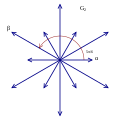 G2 group roots |
The 6 roots of the simple Lie group A2, represented by a Dynkin diagram ![]()
![]()
![]() , are in a regular hexagonal pattern. The two simple roots have a 120° angle between them.
, are in a regular hexagonal pattern. The two simple roots have a 120° angle between them.
The 12 roots of the Exceptional Lie group G2, represented by a Dynkin diagram ![]()
![]()
![]() are also in a hexagonal pattern. The two simple roots of two lengths have a 150° angle between them.
are also in a hexagonal pattern. The two simple roots of two lengths have a 150° angle between them.
Dissection
6-cube projection | 10 rhomb dissection | |
|---|---|---|
 | 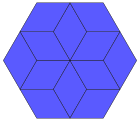 | 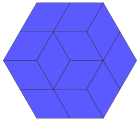 |
Coxeter states that every zonogon (a 2m-gon whose opposite sides are parallel and of equal length) can be dissected into m(m-1)/2 parallelograms.[3]
In particular this is true for regular polygons with evenly many sides, in which case the parallelograms are all rhombi. This decomposition of a regular hexagon is based on a Petrie polygon projection of a cube, with 3 of 6 square faces. Other parallelogons and projective directions of the cube are dissected within rectangular cuboids.
| Dissection of hexagons into 3 rhombs and parallelograms | |||||||||||
|---|---|---|---|---|---|---|---|---|---|---|---|
| 2D | Rhombs | Parallelograms | |||||||||
 |  |  |  | ||||||||
| Regular 6 | Hexagonal parallelogons | ||||||||||
| 3D | Square faces | Rectangular faces | |||||||||
 |  |  |  | ||||||||
Cube | Rectangular cuboid | ||||||||||
Related polygons and tilings
A regular hexagon has Schläfli symbol 6. A regular hexagon is a part of the regular hexagonal tiling, 6,3, with 3 hexagonal around each vertex.
A regular hexagon can also be created as a truncated equilateral triangle, with Schläfli symbol t3. Seen with two types (colors) of edges, this form only has D3 symmetry.
A truncated hexagon, t6, is a dodecagon, 12, alternating 2 types (colors) of edges. An alternated hexagon, h6, is a equilateral triangle, 3. A regular hexagon can be stellated with equilateral triangles on its edges, creating a hexagram. A regular hexagon can be dissected into 6 equilateral triangles by adding a center point. This pattern repeats within the regular triangular tiling.
A regular hexagon can be extended into a regular dodecagon by adding alternating squares and equilateral triangles around it. This pattern repeats within the rhombitrihexagonal tiling.
 |  |  |  |  |  |  |  |
| Regular 6 | Truncated t3 = 6 | Hypertruncated triangles | Stellated Star figure 23 | Truncated t6 = 12 | Alternated h6 = 3 | ||
|---|---|---|---|---|---|---|---|
 |  |  |  |  |
| A concave hexagon | A self-intersecting hexagon (star polygon) | Dissected 6 | Extended Central 6 in 12 | A skew hexagon, within cube |
|---|
Hexagonal structures

Giant's Causeway closeup
From bees' honeycombs to the Giant's Causeway, hexagonal patterns are prevalent in nature due to their efficiency. In a hexagonal grid each line is as short as it can possibly be if a large area is to be filled with the fewest number of hexagons. This means that honeycombs require less wax to construct and gain lots of strength under compression.
Irregular hexagons with parallel opposite edges are called parallelogons and can also tile the plane by translation. In three dimensions, hexagonal prisms with parallel opposite faces are called parallelohedrons and these can tessellate 3-space by translation.
| Form | Hexagonal tiling | Hexagonal prismatic honeycomb |
|---|---|---|
| Regular |  |  |
| Parallelogonal |  |  |
Tesselations by hexagons
In addition to the regular hexagon, which determines a unique tessellation of the plane, any irregular hexagon which satisfies the Conway criterion will tile the plane.
Hexagon inscribed in a conic section
Pascal's theorem (also known as the "Hexagrammum Mysticum Theorem") states that if an arbitrary hexagon is inscribed in any conic section, and pairs of opposite sides are extended until they meet, the three intersection points will lie on a straight line, the "Pascal line" of that configuration.
Cyclic hexagon
The Lemoine hexagon is a cyclic hexagon (one inscribed in a circle) with vertices given by the six intersections of the edges of a triangle and the three lines that are parallel to the edges that pass through its symmedian point.
If the successive sides of a cyclic hexagon are a, b, c, d, e, f, then the three main diagonals intersect in a single point if and only if ace = bdf.[4]
If, for each side of a cyclic hexagon, the adjacent sides are extended to their intersection, forming a triangle exterior to the given side, then the segments connecting the circumcenters of opposite triangles are concurrent.[5]
If a hexagon has vertices on the circumcircle of an acute triangle at the six points (including three triangle vertices) where the extended altitudes of the triangle meet the circumcircle, then the area of the hexagon is twice the area of the triangle.[6]:p. 179
Hexagon tangential to a conic section
Let ABCDEF be a hexagon formed by six tangent lines of a conic section. Then Brianchon's theorem states that the three main diagonals AD, BE, and CF intersect at a single point.
In a hexagon that is tangential to a circle and that has consecutive sides a, b, c, d, e, and f,[7]
- a+c+e=b+d+f.displaystyle a+c+e=b+d+f.
Equilateral triangles on the sides of an arbitrary hexagon

Equilateral triangles on the sides of an arbitrary hexagon
If an equilateral triangle is constructed externally on each side of any hexagon, then the midpoints of the segments connecting the centroids of opposite triangles form another equilateral triangle.[8]:Thm. 1
Skew hexagon

A regular skew hexagon seen as edges (black) of a triangular antiprism, symmetry D3d, [2+,6], (2*3), order 12.
A skew hexagon is a skew polygon with 6 vertices and edges but not existing on the same plane. The interior of such an hexagon is not generally defined. A skew zig-zag hexagon has vertices alternating between two parallel planes.
A regular skew hexagon is vertex-transitive with equal edge lengths. In 3-dimensions it will be a zig-zag skew hexagon and can be seen in the vertices and side edges of a triangular antiprism with the same D3d, [2+,6] symmetry, order 12.
The cube and octahedron (same as triangular antiprism) have regular skew hexagons as petrie polygons.
 Cube | 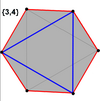 Octahedron |
Petrie polygons
The regular skew hexagon is the Petrie polygon for these higher dimensional regular, uniform and dual polyhedra and polytopes, shown in these skew orthogonal projections:
| 4D | 5D | |
|---|---|---|
 3-3 duoprism |  3-3 duopyramid |  5-simplex |
Convex equilateral hexagon
A principal diagonal of a hexagon is a diagonal which divides the hexagon into quadrilaterals. In any convex equilateral hexagon (one with all sides equal) with common side a, there exists[9]:p.184,#286.3 a principal diagonal d1 such that
- d1a≤2displaystyle frac d_1aleq 2
and a principal diagonal d2 such that
- d2a>3.displaystyle frac d_2a>sqrt 3.
Polyhedra with hexagons
There is no Platonic solid made of only regular hexagons, because the hexagons tessellate, not allowing the result to "fold up". The Archimedean solids with some hexagonal faces are the truncated tetrahedron, truncated octahedron, truncated icosahedron (of soccer ball and fullerene fame), truncated cuboctahedron and the truncated icosidodecahedron. These hexagons can be considered truncated triangles, with Coxeter diagrams of the form ![]()
![]()
![]()
![]()
![]() and
and ![]()
![]()
![]()
![]()
![]() .
.
| Hexagons in Archimedean solids | |||||||||||
|---|---|---|---|---|---|---|---|---|---|---|---|
Tetrahedral | Octahedral | Icosahedral | |||||||||
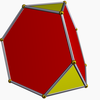 truncated tetrahedron | 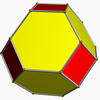 truncated octahedron |  truncated cuboctahedron | 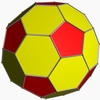 truncated icosahedron |  truncated icosidodecahedron | |||||||
There are other symmetry polyhedra with stretched or flattened hexagons, like these Goldberg polyhedron G(2,0):
| Hexagons in Goldberg polyhedra | |||||||||||
|---|---|---|---|---|---|---|---|---|---|---|---|
Tetrahedral | Octahedral | Icosahedral | |||||||||
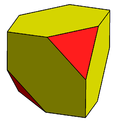 Chamfered tetrahedron | 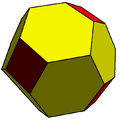 Chamfered cube | 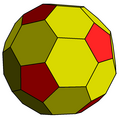 Chamfered dodecahedron | |||||||||
There are also 9 Johnson solids with regular hexagons:
| Johnson solids and near-misses with hexagons | |||||||||||
|---|---|---|---|---|---|---|---|---|---|---|---|
 triangular cupola |  elongated triangular cupola |  gyroelongated triangular cupola | |||||||||
 augmented hexagonal prism |  parabiaugmented hexagonal prism |  metabiaugmented hexagonal prism |  triaugmented hexagonal prism | ||||||||
 augmented truncated tetrahedron |  triangular hebesphenorotunda |  Truncated triakis tetrahedron |  | ||||||||
Prismoids with hexagons | |||||||||||
|---|---|---|---|---|---|---|---|---|---|---|---|
 Hexagonal prism |  Hexagonal antiprism | 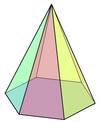 Hexagonal pyramid | |||||||||
| Tilings with regular hexagons | |||||||||||
|---|---|---|---|---|---|---|---|---|---|---|---|
| Regular | 1-uniform | ||||||||||
6,3 | r6,3 | rr6,3 | tr6,3 | ||||||||
 |  |  | 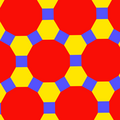 | ||||||||
2-uniform tilings | |||||||||||
 | 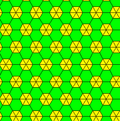 |  |  | ||||||||
Hexagons: natural and human-made

The ideal crystalline structure of graphene is a hexagonal grid.

Assembled E-ELT mirror segments

A beehive honeycomb

The scutes of a turtle's carapace

North polar hexagonal cloud feature on Saturn, discovered by Voyager 1 and confirmed in 2006 by Cassini [1] [2] [3]

Micrograph of a snowflake

Benzene, the simplest aromatic compound with hexagonal shape.

Hexagonal order of bubbles in a foam.

Crystal structure of a molecular hexagon composed of hexagonal aromatic rings reported by Müllen and coworkers in Chem. Eur. J., 2000, 1834-1839.

Naturally formed basalt columns from Giant's Causeway in Northern Ireland; large masses must cool slowly to form a polygonal fracture pattern

An aerial view of Fort Jefferson in Dry Tortugas National Park

The James Webb Space Telescope mirror is composed of 18 hexagonal segments.

Metropolitan France has a vaguely hexagonal shape. In French, l'Hexagone refers to the European mainland of France aka the "métropole" as opposed to the overseas territories such as Guadeloupe, Martinique or French Guiana.
Hexagonal Hanksite crystal, one of many hexagonal crystal system minerals

Hexagonal barn

The Hexagon, a hexagonal theatre in Reading, Berkshire

Władysław Gliński's hexagonal chess

Pavilion in the Taiwan Botanical Gardens

Hexagonal window
See also
24-cell: a four-dimensional figure which, like the hexagon, has orthoplex facets, is self-dual and tessellates Euclidean space- Hexagonal crystal system
- Hexagonal number
Hexagonal tiling: a regular tiling of hexagons in a plane
Hexagram: 6-sided star within a regular hexagon
Unicursal hexagram: single path, 6-sided star, within a hexagon- Honeycomb conjecture
References
^ Wenninger, Magnus J. (1974), Polyhedron Models, Cambridge University Press, p. 9, ISBN 9780521098595.mw-parser-output cite.citationfont-style:inherit.mw-parser-output .citation qquotes:"""""""'""'".mw-parser-output .citation .cs1-lock-free abackground:url("//upload.wikimedia.org/wikipedia/commons/thumb/6/65/Lock-green.svg/9px-Lock-green.svg.png")no-repeat;background-position:right .1em center.mw-parser-output .citation .cs1-lock-limited a,.mw-parser-output .citation .cs1-lock-registration abackground:url("//upload.wikimedia.org/wikipedia/commons/thumb/d/d6/Lock-gray-alt-2.svg/9px-Lock-gray-alt-2.svg.png")no-repeat;background-position:right .1em center.mw-parser-output .citation .cs1-lock-subscription abackground:url("//upload.wikimedia.org/wikipedia/commons/thumb/a/aa/Lock-red-alt-2.svg/9px-Lock-red-alt-2.svg.png")no-repeat;background-position:right .1em center.mw-parser-output .cs1-subscription,.mw-parser-output .cs1-registrationcolor:#555.mw-parser-output .cs1-subscription span,.mw-parser-output .cs1-registration spanborder-bottom:1px dotted;cursor:help.mw-parser-output .cs1-ws-icon abackground:url("//upload.wikimedia.org/wikipedia/commons/thumb/4/4c/Wikisource-logo.svg/12px-Wikisource-logo.svg.png")no-repeat;background-position:right .1em center.mw-parser-output code.cs1-codecolor:inherit;background:inherit;border:inherit;padding:inherit.mw-parser-output .cs1-hidden-errordisplay:none;font-size:100%.mw-parser-output .cs1-visible-errorfont-size:100%.mw-parser-output .cs1-maintdisplay:none;color:#33aa33;margin-left:0.3em.mw-parser-output .cs1-subscription,.mw-parser-output .cs1-registration,.mw-parser-output .cs1-formatfont-size:95%.mw-parser-output .cs1-kern-left,.mw-parser-output .cs1-kern-wl-leftpadding-left:0.2em.mw-parser-output .cs1-kern-right,.mw-parser-output .cs1-kern-wl-rightpadding-right:0.2em.
^ John H. Conway, Heidi Burgiel, Chaim Goodman-Strauss, (2008) The Symmetries of Things,
ISBN 978-1-56881-220-5 (Chapter 20, Generalized Schaefli symbols, Types of symmetry of a polygon pp. 275-278)
^ Coxeter, Mathematical recreations and Essays, Thirteenth edition, p.141
^ Cartensen, Jens, "About hexagons", Mathematical Spectrum 33(2) (2000–2001), 37–40.
^ Dergiades, Nikolaos (2014). "Dao's theorem on six circumcenters associated with a cyclic hexagon". Forum Geometricorum. 14: 243–246.
^ Johnson, Roger A., Advanced Euclidean Geometry, Dover Publications, 2007 (orig. 1960).
^ Gutierrez, Antonio, "Hexagon, Inscribed Circle, Tangent, Semiperimeter", [4], Accessed 2012-04-17.
^ Dao Thanh Oai (2015). "Equilateral triangles and Kiepert perspectors in complex numbers". Forum Geometricorum. 15: 105–114.
^ Inequalities proposed in “Crux Mathematicorum”, [5].
External links
| Look up hexagon in Wiktionary, the free dictionary. |
- Weisstein, Eric W. "Hexagon". MathWorld.
This article's use of external links may not follow Wikipedia's policies or guidelines. (November 2017) (Learn how and when to remove this template message) |
Definition and properties of a hexagon with interactive animation and construction with compass and straightedge.
An Introduction to Hexagonal Geometry on Hexnet a website devoted to hexagon mathematics.
Cymatics – Hexagonal shapes occurring within water sound images[dead link]- Cassini Images Bizarre Hexagon on Saturn
- Saturn's Strange Hexagon
- A hexagonal feature around Saturn's North Pole
"Bizarre Hexagon Spotted on Saturn" – from Space.com (27 March 2007)
Fundamental convex regular and uniform polytopes in dimensions 2–10 | ||||||||||||
|---|---|---|---|---|---|---|---|---|---|---|---|---|
Family | An | Bn | I2(p) / Dn | E6 / E7 / E8 / F4 / G2 | Hn | |||||||
Regular polygon | Triangle | Square | p-gon | Hexagon | Pentagon | |||||||
Uniform polyhedron | Tetrahedron | Octahedron • Cube | Demicube | Dodecahedron • Icosahedron | ||||||||
Uniform 4-polytope | 5-cell | 16-cell • Tesseract | Demitesseract | 24-cell | 120-cell • 600-cell | |||||||
Uniform 5-polytope | 5-simplex | 5-orthoplex • 5-cube | 5-demicube | |||||||||
Uniform 6-polytope | 6-simplex | 6-orthoplex • 6-cube | 6-demicube | 122 • 221 | ||||||||
Uniform 7-polytope | 7-simplex | 7-orthoplex • 7-cube | 7-demicube | 132 • 231 • 321 | ||||||||
Uniform 8-polytope | 8-simplex | 8-orthoplex • 8-cube | 8-demicube | 142 • 241 • 421 | ||||||||
Uniform 9-polytope | 9-simplex | 9-orthoplex • 9-cube | 9-demicube | |||||||||
Uniform 10-polytope | 10-simplex | 10-orthoplex • 10-cube | 10-demicube | |||||||||
| Uniform n-polytope | n-simplex | n-orthoplex • n-cube | n-demicube | 1k2 • 2k1 • k21 | n-pentagonal polytope | |||||||
| Topics: Polytope families • Regular polytope • List of regular polytopes and compounds | ||||||||||||


































